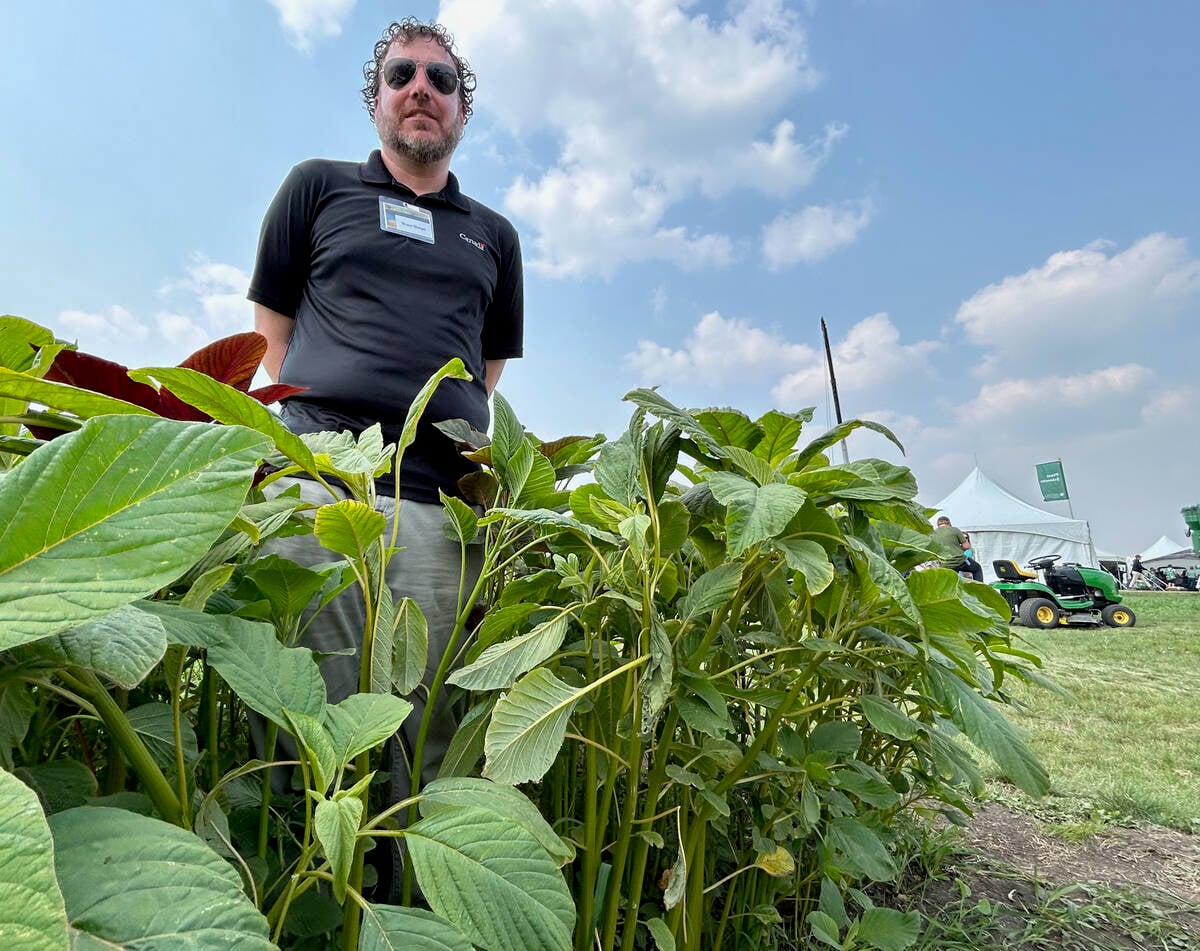You wouldn’t buy a brand new house without purchasing a home insurance policy, and you wouldn’t take that classic Corvette out for a spin without auto insurance.
That line of thinking can also apply to farming. As a farmer, if there’s something you can do to protect your investment, odds are you’re going to do it.
Perhaps that’s why midge tolerant wheat (MTW) has become a popular option for many growers since it was launched commercially in Canada in 2010. Not only does it greatly limit costly damage caused by infestations of orange wheat blossom midge, but it can also produce higher yields than many other varieties of wheat.
Read Also

Glufosinate-resistant waterhemp appears in U.S. Midwest
News of glufosinate-resistant kochia in the U.S. is concerning as farmers are losing options to control waterhemp, also of the pigweed family.
“I often say to people that midge tolerant wheat is very cheap insurance,” says Ron DePauw, a veteran plant breeder who serves as a science advisor to seed supplier SeCan.
“Some of the top midge tolerant wheat varieties have not only the Sm1 gene (to fight wheat midge), but are high yielding in the absence of midge, they have strong stature and a robust disease resistance package including resistance to fusarium. To me, that’s pretty cheap insurance.”
The benefits of midge tolerant wheat are obvious. It’s estimated to have saved western Canadian producers more than $3 billion in yield losses and grade dockage since it was introduced commercially in this country a little more than a decade ago.
Despite exhaustive research here in Canada, the United States and Europe, the Sm1 gene remains the only gene that provides midge tolerance in wheat. That’s why it is important to protect the trait — it remains the only effective tool in mitigating damage caused by wheat midge.
As part of the efforts to ensure the effectiveness of the Sm1 gene for future use, farmers who grow midge tolerant wheat must sign an online stewardship agreement with their retailers and follow a list of requirements (found at midgetolerantwheat.ca). That includes limiting the use of farm-saved seed to one generation past certified. This limit helps to keep an interspersed refuge system in MTW at the proper level, which in turn helps to prevent the buildup of resistant midge. Without the proper refuge, midge tolerance could break down within 10 years.
“This is the only gene that we have (for midge tolerance). There is no plan B,” DePauw explains. “That’s why the stewardship agreement is so important.
“Protecting the Sm1 gene is basically in the hands of farmers. The agreement is not onerous. No one’s going to come around and be pounding on your door or looking inside your granary. The onus is on the individual farmer and all of the farmers who use midge tolerant wheat to protect this technology we’ve got.”

Early success
Jake Ayre helps run family-owned J&C Farms near Minto, Man., with his parents and sister. The 2,200-acre farm is predominantly a pedigreed seed operation but also grows cash crops such as corn, canola and commercial soybeans. Although it hasn’t had to deal with any wheat midge issues in several years, it did have to contend with a couple of infestations back in the early 2000s.
While the farm’s seed operation has sold midge tolerant wheat seed for the past couple of years, this past year was the first time Ayre also grew it as a crop. He decided to try it after a field of winter wheat didn’t survive last winter and he was unable to use the field for cereal seed production. He planted a certified AAC Wheatland varietal blend after hearing how other farmers in the area had enjoyed success using it and wanted to see if it could be a potential fit for his farm’s seed operation.
“Overall, I was very happy with how it stood up and the yield,” Ayre says. “I would think about planting it again for sure. The yield bump was definitely something we saw. It did a couple of bushels better on average than the rest of the wheat on our farm did.”
Ayre was already familiar with the stewardship agreement for midge tolerant wheat since he was required to take a stewardship course and sign a stewardship agreement in order to sell MTW seed. He says he fully supports the aims of the stewardship agreement, especially since technology use agreements (TUA) have become fairly commonplace in agriculture.
“Maybe I’m indifferent, being part of the younger generation, but it could also be the understanding that this is technology that has been developed, and to keep it around and keep it available and to give access to producers to a tool that some may desperately need if midge is something they struggle with on their farms, we need to protect it,” he says.
Pays for itself
DePauw, who helped develop one of the first midge tolerant wheat varieties in Canada, says even though MTW may cost slightly more to plant, it can end up paying for itself in relatively short order.
Studies have indicated midge tolerant wheat can provide as much as $70 an acre in yield and grade benefits. That means if wheat is selling at $10 a bushel and you have 1,000 acres planted, you could realize as much as $70,000 in savings. Conversely, if midge damage does occur, it could mean in the case of hard red spring wheat a drop in price of $4 a ton if it’s downgraded from one to two Canadian Western Red Spring (CWRS) market grade or as much as $10 a ton if it drops from a grade of one to three. It could also mean a loss of as much as 50 per cent of your yield under very high midge pressure, DePauw adds.

Ticking time bomb
Tyler Wist is a researcher with Agriculture and Agri-Food Canada (AAFC) in Saskatoon, Sask., who specializes in wheat insects including wheat midge.
Wist describes wheat midge as a “ticking time bomb” because the insects can remain dormant in the ground for long periods of time if conditions above ground are less than ideal for them. They usually begin to emerge when a large, saturating rainfall occurs in the springtime. Another challenge, he says, is the fact that wheat midge are extremely small (less than three millimetres in size) and usually only come out at night, making them difficult to spot in a field.
Adding to an already difficult situation is the fact there aren’t many chemical solutions available to fight wheat midge. Dimethoate is the only chemical currently registered for use on them and while it’s relatively efficient on adults, it isn’t very effective in killing midge larva or eggs. Wist cautions against the use of pesticides with wheat midge since they can also eliminate beneficial insects such as parasitoids, which can help keep wheat midge populations low.
It’s the larvae of the wheat midge that cause damage to the plant. After they hatch, the midge larvae feed on the developing wheat kernels, causing them to shrivel, crack and become deformed. Damage to the crop is not readily apparent because there are no visible changes in colour, size or shape of the affected wheat heads.
Wist says wheat midge have a highly developed sense of smell and it’s the wheat’s scent that attracts female midge, which lay the eggs that lead to the larval damage to the seeds. He says the Sm1 gene in MTW works by producing a taste midge don’t like, which causes them to stop eating and starve to death.
“Preserving that (trait) is absolutely essential. We have never found anything else that works nearly as well as that,” he explains.
“Having that 10 per cent refuge in there, theoretically, it keeps the wheat midge from developing resistance. Even if you get a few that are resistant to the Sm1 gene, it’s essentially bred out because they’re not going to find each other to mate, whereas if you had a whole field of Sm1 wheat and you’ve only got three or four wheat midge that survived the Sm1 onslaught, they’re going to find each other and they’re going to breed and they’re going to pass on their resistance to the next generation.”
Wist says it’s important farmers don’t get lulled into a false sense of security just because they don’t appear to have a problem with midge at a given time. Even though wheat midge forecasts for 2022 showed this member of the fly family posed little risk, pheromone trap counts in some areas were unexpectedly high, he adds.

“My take-home message from 2022 is we can’t turn our backs on wheat midge. You never know when it’s going to strike or where it’s going to strike. Even though we can forecast for it, the forecast is still a best guess,” he says.
DePauw agrees.
“You might not appear to have any losses, but I think of midge damage as an iceberg. What you see in your grain sample is just the tip of the iceberg,” he says. “Those are just the kernels that were large enough to be retained in the harvest sample. You have no clue what was blowing out of the back of a combine with the chaff.”
More options
The number of midge tolerant wheat varieties has grown dramatically over the last few years. There are now more than three dozen different varieties available commercially including 21 hard red spring varieties alone. The good news, DePauw says, is in addition to being midge tolerant, many of these varieties have several other valuable attributes including robust disease resistance packages.
Ask the experts
Ayre’s advice to growers who aren’t sure about whether midge tolerant wheat is right for them is to talk to their local seed growers about what their experiences have been with different MTW varieties and to check out their provincial seed guides.
“I would definitely encourage someone to look at growing it on (his or her) farm. The possibility of (increased yield and grade benefits) is definitely something to look at in these times with tight margins in agriculture.”
















